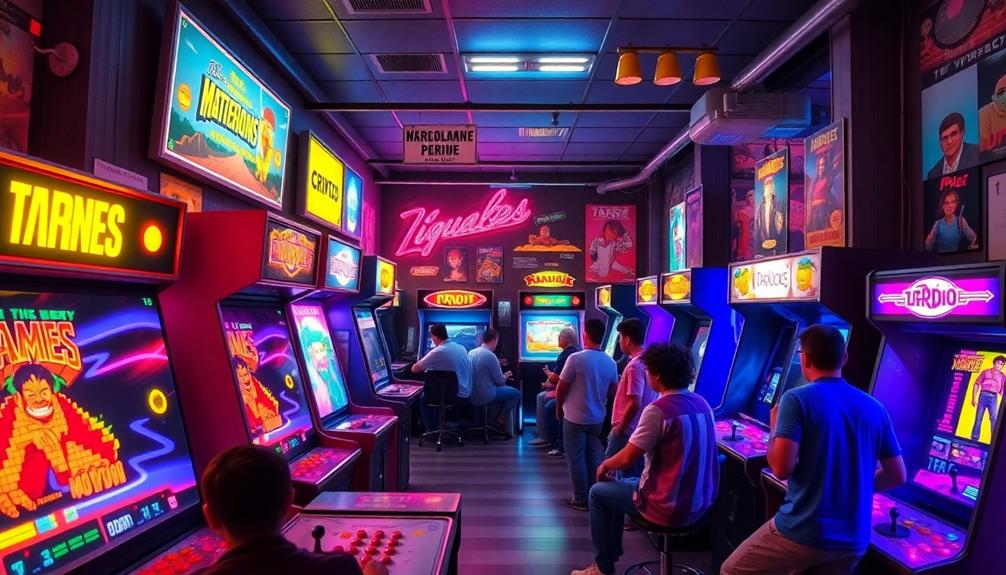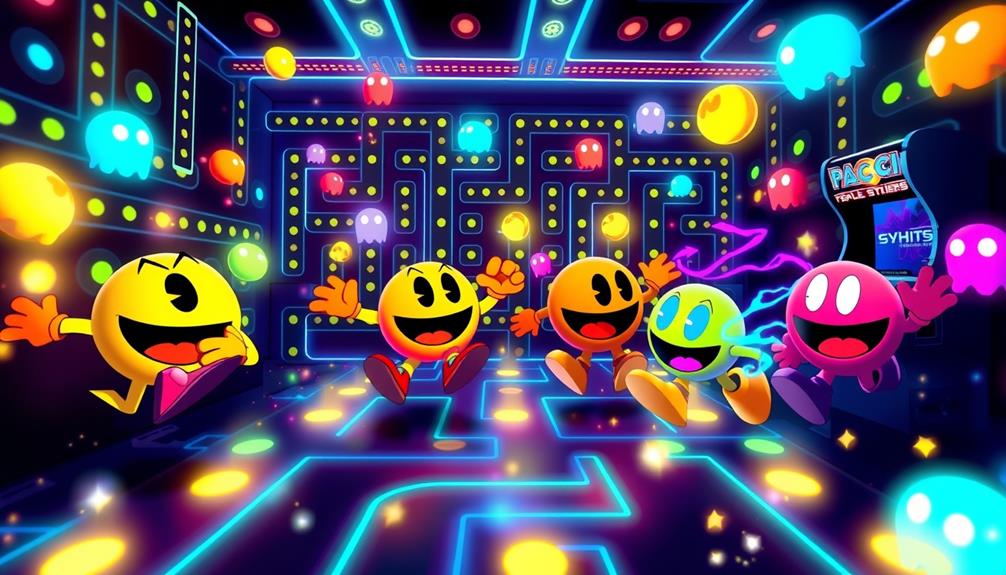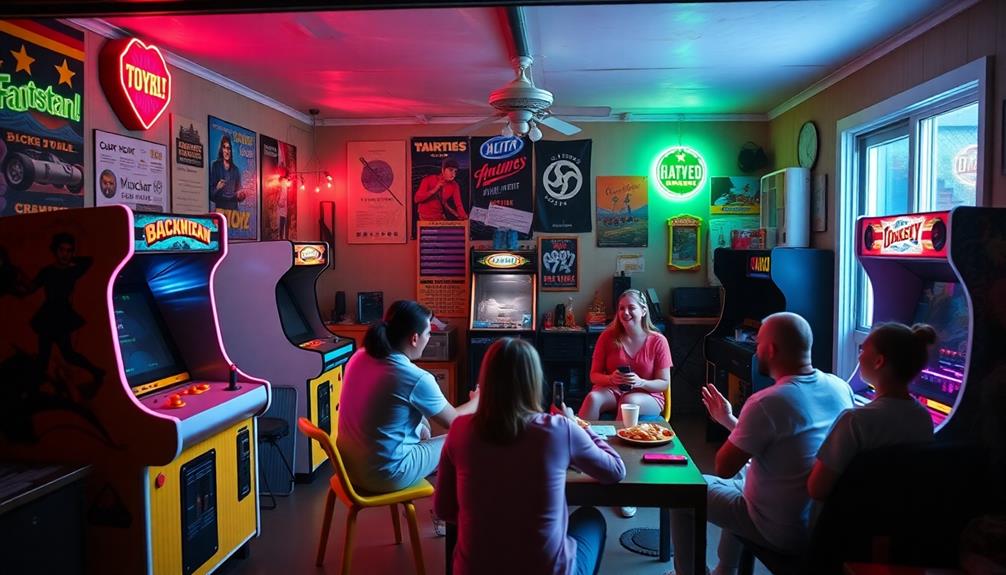Arcade games became extremely popular in the 1980s due to their creative gameplay and colorful visuals that immediately caught your eye. Games like Pac-Man, Donkey Kong, and Space Invaders not only brought exciting mechanics but also encouraged a sense of camaraderie as players gathered in arcades for friendly competitions. The technological improvements, such as enhanced graphics and digital sound, provided immersive experiences that kept players wanting more. Additionally, with affordable prices for gameplay, a whole generation of gamers eagerly embraced this cultural phenomenon. Interested in learning more about how these elements influenced the gaming industry? There’s more to explore!
Key Takeaways
- The introduction of iconic titles like *Pac-Man* and *Donkey Kong* created lasting appeal and cultural significance, attracting millions of players.
- Technological advancements, including RGB graphics and digital audio, enhanced the immersive gameplay experience, making arcade games visually appealing and engaging.
- Arcades became social hubs, fostering community interaction and friendly competition among players, enhancing the overall gaming experience.
- The affordability of 25-cent games made arcade gaming accessible to a diverse audience, contributing to the industry's rapid growth.
- Marketing strategies, including merchandise and film tie-ins, increased visibility and solidified the cultural impact of arcade games in the 80s.
The Golden Age of Arcades
If you've ever stepped into a bustling arcade, you can feel the excitement that defined the Golden Age of arcades from the late 1970s to the mid-1980s. This era marked a revolution in entertainment, with arcade games capturing the imaginations of players everywhere. It all kicked off with the release of *Space Invaders* in 1978, which skyrocketed the popularity of arcade gaming and set a new standard for fun.
By 1982, the arcade industry generated over $8 billion in revenue, outpacing both the music and film industries combined. During this time, the number of video game arcades doubled, reaching a staggering 10,000 in North America, all featuring about 1.5 million arcade machines.
Iconic titles like *Pac-Man*, *Donkey Kong*, and *Frogger* became household names, with *Pac-Man* alone selling over 400,000 cabinets and grossing more than $1 billion by 1981. The games not only thrilled players but also fostered social connections, similar to how astrology influences self-image and confidence today.
The Golden Age of arcade games was more than just numbers; it was about the thrilling experiences that kept you coming back for more. It's a time when gaming became a social phenomenon, and the joy of friendly competition flourished.
Technological Advancements
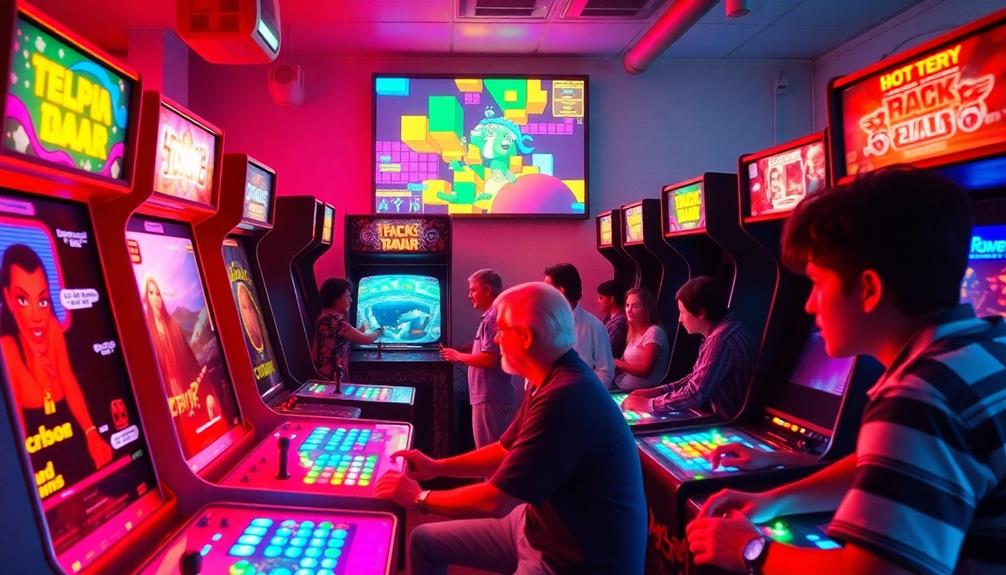
The rapid technological advancements in the late 1970s and early 1980s transformed arcade gaming, making it more vibrant and engaging than ever before. The introduction of RGB color graphics brought a new level of visual appeal, allowing games to burst with color and detail. You found yourself enthralled by the stunning visuals that enhanced your gaming experience.
Additionally, vector displays and stereoscopic 3D technology created immersive gameplay, pulling you deeper into the game worlds. This era also saw the rise of pinball machines, which became a staple in arcades and bars due to their dynamic gameplay and innovative designs.
Digital audio innovations improved sound quality, crafting dynamic soundscapes that complemented the action on-screen. This auditory enhancement drew in crowds, as you enjoyed not just the visuals but also the fascinating sounds that accompanied each game.
The introduction of new gameplay mechanics, like multiple lives in *Space Invaders*, made games more accessible and enjoyable, allowing you to play longer and improve your skills.
Moreover, rapid hardware evolution led to diverse gameplay styles, fostering new genres such as maze chase, action, and skill-based games. This constant innovation kept you engaged and enthusiastic to return to the arcade, as each visit promised fresh challenges and experiences that you couldn't resist.
Iconic Games and Their Impact

When you think about iconic arcade games from the 80s, it's clear they changed everything. Titles like Pac-Man and Space Invaders not only introduced innovative game mechanics but also became cultural icons that resonate with players today.
Their lasting appeal continues to influence new generations, reminding us of the joy and excitement they brought to gaming.
Additionally, the rise of home arcade machines has allowed fans to recreate that nostalgic experience in their own game rooms, offering best arcade machines that capture the essence of those classic titles.
Game Mechanics Innovation
As arcade games evolved in the 80s, innovation in game mechanics became a driving force behind their popularity and cultural impact. Iconic titles like *Pac-Man* transformed gameplay with maze-chase mechanics and a lovable mascot, creating a connection that drew players in. This was more than just a coin-operated game; it ignited a phenomenon that defined the era, demonstrating the power of nurturing an imaginative mindset in the gaming industry.
*Space Invaders* changed the landscape of shooting games with its innovative mechanics, allowing you to earn multiple lives and paving the way for future fixed shooter games.
Then there's *Donkey Kong*, which kicked off the platform genre by weaving character-driven narratives into its gameplay. This blend of storytelling and challenge attracted a wider audience and set a standard for future classics.
The introduction of skill-based mechanics in games like *Qix* shifted the focus from frantic shooting to timing and coordination, enhancing the overall experience.
Meanwhile, titles such as *Defender* and *Asteroids* utilized cutting-edge technology, like vector graphics and side-scrolling, pushing gameplay boundaries.
This game mechanics innovation guaranteed that classic arcade games not only entertained but also left a lasting mark on video gaming history.
Cultural Phenomenon Influence
Arcade games in the 80s weren't just entertainment; they became cultural icons that shaped social interactions and gaming culture. Games like *Pac-Man* and *Space Invaders* weren't just played; they defined an era, with *Pac-Man* earning over $1 billion by 1981.
These games transformed video arcades into vibrant social hubs, where you and your friends could chase high scores and bragging rights. The introduction of recognizable characters and engaging narratives, as seen in *Donkey Kong*, brought a wider audience into these spaces, making gaming more relatable and exciting.
Additionally, the cultural phenomenon of these games can be likened to today's celebrity relationships, where individuals navigate public and private lives while maintaining connections, such as Jennifer Aniston and Brad Pitt's friendly connection.
The peak of the arcade industry in 1982, with around 24,000 full arcades and 1.5 million machines, shows just how integral these games were to everyday life. Titles like *Frogger* and *BurgerTime* offered simple yet addictive gameplay, fostering a community of frequent players who'd gather to share strategies and experiences.
Marketing strategies, including tie-ins with films and merchandise, helped solidify these arcade games as a cultural phenomenon. Events like "Pac-Mania" further ingrained these games into popular culture, ensuring they left a lasting impact on society.
Lasting Nostalgic Appeal
The nostalgic appeal of iconic games from the 80s, like *Pac-Man* and *Space Invaders*, continues to resonate with players today. These arcade games weren't just entertainment; they became cultural phenomena that shaped the gaming landscape.
*Pac-Man* generated over $1 billion in revenue by 1981, establishing a beloved gaming mascot. Similarly, *Space Invaders* transformed arcade gaming, grossing $2 billion by 1982 and setting the standard for shoot 'em up games. The influence of these games can be seen in modern gaming trends, as young tennis prodigies showcase their exceptional skills, much like how these iconic games showcased innovative gameplay.
When you think of other classics, like *Donkey Kong*, released in 1981, the impact deepens. It introduced memorable characters like Mario, leaving a legacy that influences games even now.
Titles like *Ms. Pac-Man* and *Asteroids* further built on this momentum, with *Asteroids* becoming Atari's top coin-operated game at the time.
Today, the nostalgic appeal is evident at retro-themed events and parties, where players celebrate the social experiences shared in video arcades during the 80s.
You can feel the excitement and camaraderie that these games fostered, reminding everyone why they remain treasured within the gaming community.
Social Interaction in Arcades
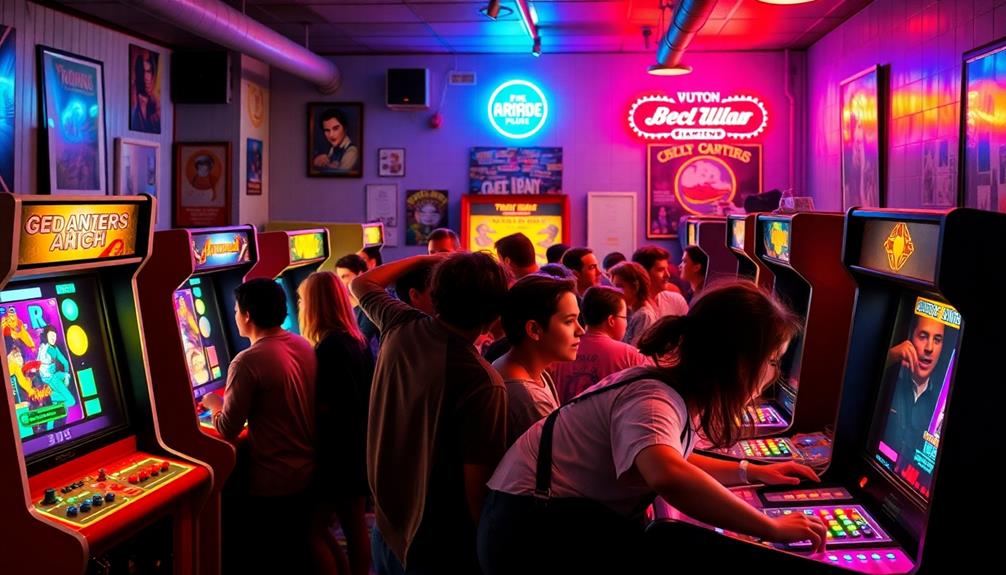
While many people flocked to arcades for the thrill of gaming, these vibrant spaces also became essential hubs for social interaction. You'd find friends and strangers alike competing for high scores on iconic arcade games like Pac-Man and Donkey Kong. The atmosphere buzzed with energy, fostering a sense of community among over 35 million gamers visiting U.S. arcades by 1981.
Themed parties and events in arcades often enhanced the experience, creating a more immersive environment for those who gathered to play and socialize, similar to how unique party options enhance celebrations.
During peak hours, especially at lunchtime, players engaged in friendly competition, creating camaraderie as they cheered each other on or playfully mocked their friends' attempts. The combination of vibrant visuals, immersive sounds, and engaging gameplay made arcades irresistible venues for socializing.
You could easily plunge into various fantasy scenarios alongside fellow gamers, sharing laughter and excitement.
Events and tournaments further encouraged social interaction, building a culture that extended beyond the games. Players returned not just for the thrill of arcade games but also for the rich social experiences that came with them.
In this way, arcades became more than just places to play; they transformed into community centers where memories were forged through shared victories and challenges.
Cultural Phenomenon and Legacy
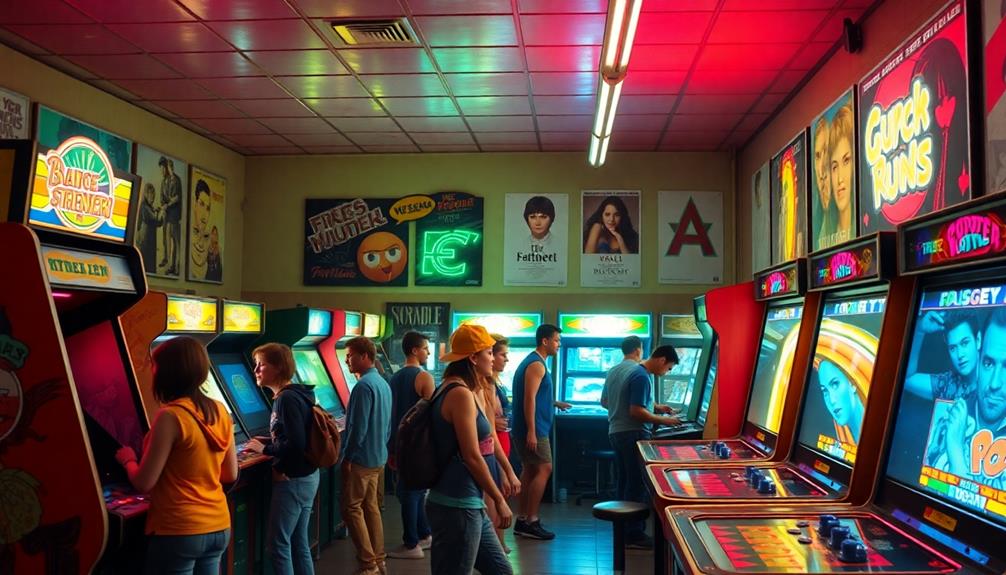
Arcade games in the 80s became vibrant social gathering spaces where you and your friends could connect and compete. The thrill of inserting coins and mastering a high score created a sense of community that was unique to that era, much like the joy captured in songs like Blue Skies and Lemonade.
Their lasting nostalgic appeal continues to shape popular culture, influencing everything from music to fashion. Even today, you can see their impact in retro-themed events that celebrate the classics you once loved.
Social Gathering Spaces
Video game arcades in the 80s transformed into vibrant social hubs where gamers of all ages came together to share their passion. With over 35 million gamers visiting arcades in the U.S. by 1981, these social gathering spaces fostered a lively community culture.
In a time when digital connectivity was limited, these arcades served as essential environments for fostering curiosity and happiness through shared experiences. You'd often find players competing for high scores, engaging in friendly rivalries that made the atmosphere electric.
The iconic sounds and visuals of arcade games like Pac-Man and Q*Bert created a shared cultural experience that resonated across various demographics. Many arcades were conveniently located in shopping malls and entertainment venues, making them popular hangout spots for both youth and adults.
These spaces encouraged informal tournaments, where players bonded over shared achievements and challenges.
As you reminisced about your time in these bustling arcades, the nostalgia for that vibrant community culture still lingers. Today, retro-themed events and establishments aim to capture that same communal spirit, reminding us of the joy and camaraderie arcade games brought into our lives.
The legacy of these social gathering spaces continues to influence modern gaming, proving that the connections formed in arcades are timeless.
Lasting Nostalgic Appeal
The nostalgic allure of 80s arcade games remains a powerful cultural phenomenon, enchanting both those who experienced it firsthand and new generations. The iconic sounds of *Pac-Man* and the vibrant visuals defined an era that many remember fondly, creating a lasting nostalgic appeal.
The impact of these coin-operated games extended beyond the gaming console; they became embedded in 80s culture, influencing films like *Tron* and TV shows such as *The Goldbergs*. Additionally, the social dynamics around these games often mirrored relationship patterns, where players formed bonds through shared experiences, much like managing trust issues with boyfriends in modern times trust issues with partners.
Today, retro-themed events and parties celebrate these classic arcade games, drawing in both older players reminiscing about their childhood and younger gamers enthusiastic to experience the magic. Local establishments have embraced this sentiment, hosting community events centered around arcade themes, like retro pinball bars that uplift spirits in hospitals.
The legacy of arcade gaming continues to thrive, as the excitement and camaraderie shared in those bustling gaming halls resonate with people of all ages.
Whether you're reliving the joy of chasing high scores or experiencing the thrill for the first time, the charm of 80s arcade games remains irresistible, creating connections that span generations.
Impact on Popular Culture
Transforming entertainment and social interaction, the rise of 80s arcade games left an indelible mark on popular culture. Titles like *Pac-Man* didn't just dominate the gaming scene; they sparked a cultural phenomenon that permeated various aspects of life.
"Pac-Mania" was everywhere, with merchandise, music, and even food inspired by the iconic yellow character. You could see references in films like *Tron* and TV shows such as *The Goldbergs*, highlighting how arcade games shaped the media landscape.
Arcades became communal hubs where people of all ages gathered, fostering social interactions and friendly competition. By 1981, over 35 million gamers flocked to these venues, proving their widespread appeal.
The distinct sounds and gameplay of classics like *Pac-Man* and *Q*Bert* created a unique atmosphere that resonated deeply with players and left a lasting legacy.
Today, nostalgia for the arcade culture persists, reminding you of simpler times spent with friends in front of flickering screens.
The impact of 80s arcade games on popular culture is undeniable, as their influence continues to be felt in modern gaming and media.
Economic Influence and Accessibility
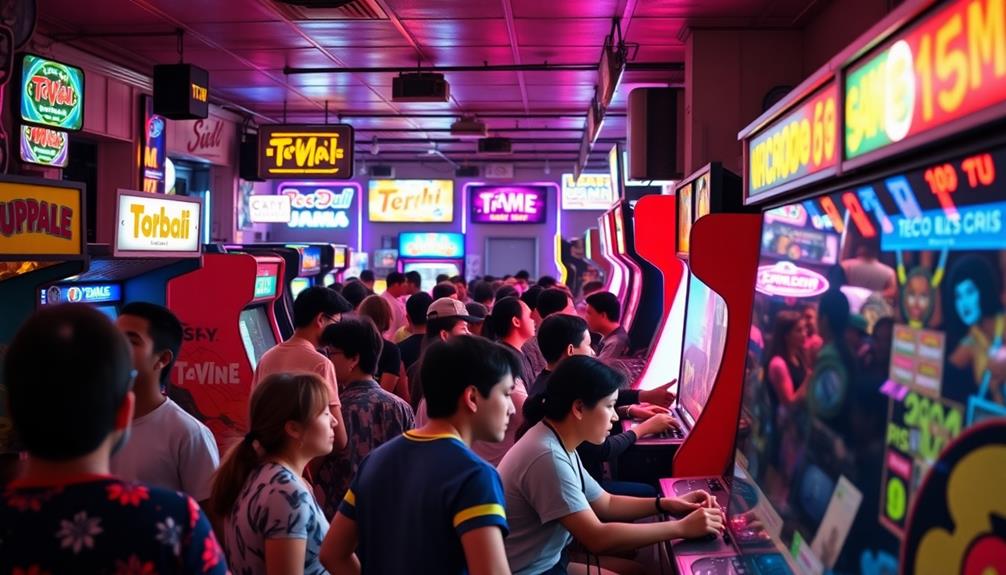
Arcade games in the 80s became a cultural phenomenon that not only captivated gamers but also greatly influenced the economy. By 1982, the U.S. arcade industry generated an astonishing annual gross revenue of $8 billion, outpacing both the music and film industries combined. This financial success was driven by popular arcade machines, often located in prime spots, raking in up to $400 per week.
| Year | Arcade Locations | Average Cost to Play |
|---|---|---|
| 1980 | 5,000 | $0.25 |
| 1981 | 7,500 | $0.25 |
| 1982 | 10,000 | $0.25 |
With over 35 million gamers visiting video game arcades in 1981, it's clear that arcade games offered an accessible and affordable form of entertainment. The average cost of just 25 cents per play made it easy for many to join the fun. The number of arcades doubled from 1980 to 1982, reflecting the skyrocketing demand for these engaging gaming experiences. Arcade games truly reshaped both entertainment and economic landscapes during the 80s.
Frequently Asked Questions
Why Were Arcades so Popular in the 80S?
Arcades drew you in with their vibrant atmosphere and social interactions. You'd gather with friends, compete for high scores, and enjoy addictive gameplay, making each visit an exciting escape filled with cutting-edge technology and fun.
When Were Arcade Games Most Popular?
Arcade games were most popular in the early 1980s, peaking in 1982. You'd find packed arcades, buzzing with excitement, as millions flocked to experience the latest games, making it a vibrant social scene. There were several reasons for arcade game popularity during this time. For one, the games offered a unique and immersive experience that couldn’t be replicated at home. The competitive nature of arcade games also appealed to both casual and serious gamers, creating a sense of challenge and camaraderie among players. Additionally, the graphics and technology of these games were cutting edge for the time, drawing in crowds eager to experience the latest advancements in gaming. Another reason people love arcade games is the nostalgia they bring. Many adults today remember spending hours at the local arcade, creating fond memories that they cherish to this day. The social aspect of arcade gaming also contributed to its popularity, as friends and family would gather to enjoy the excitement and competition together. These reasons people love arcade games helped to create a powerful and lasting cultural phenomenon that continues to resonate with people of all ages.
When Was the Golden Age of Arcades?
The golden age of arcades spans from the late 1970s to the mid-1980s. You'll find this period marked by iconic games like *Space Invaders*, which sparked a massive surge in arcade popularity and innovation.
When Did Arcade Games Lose Popularity?
As a vibrant carnival fades at dusk, arcade games began losing popularity in the late 1980s. Home consoles emerged, offering convenience and variety, drawing players away from the once-bustling arcade scene to their living rooms.
Conclusion
Arcade games in the '80s weren't just about pixels and high scores; they were vibrant hubs of social interaction and competition. While today's gaming often isolates you behind a screen, back then, the thrill of sharing a joystick or cheering on a friend created lasting memories. The clash of technology and community defined an era, leaving a legacy that still resonates today. As you reflect on those neon-lit rooms, remember: gaming was never just a pastime; it was a cultural revolution.
